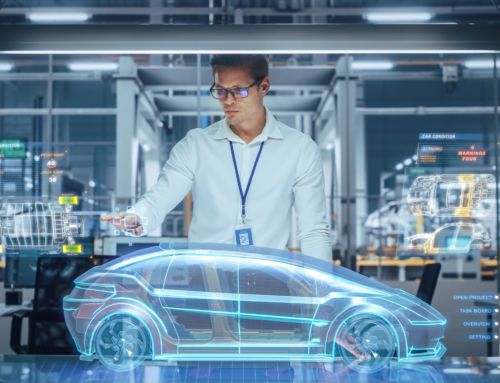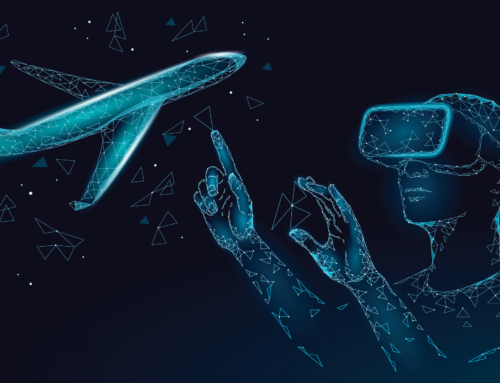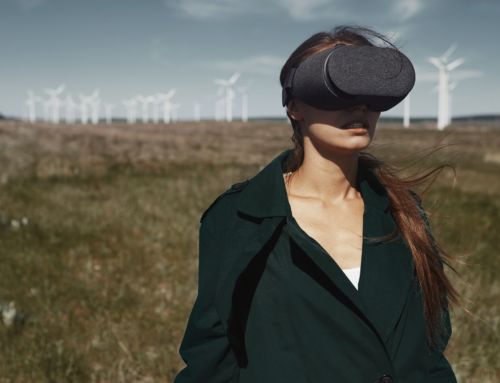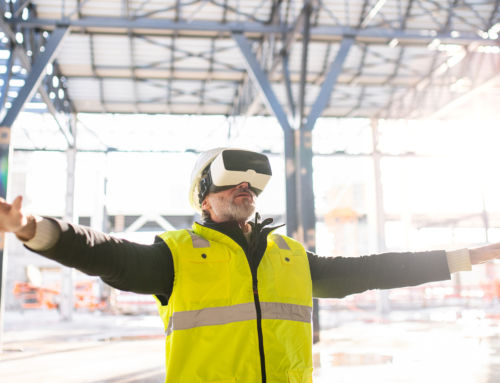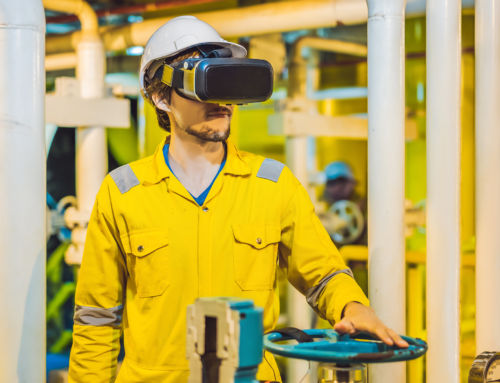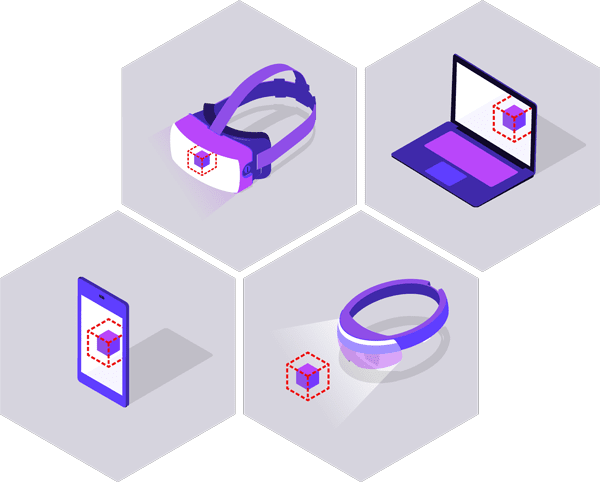Key Takeaways
Why opt for a blended learning approach?
Blended learning is a strategy that mixes traditional learning methods, such as face-to-face interaction with an instructor in a classroom setting or two dimensional online learning, with personalised, interactive e-learning.
Learning practitioners and learners worldwide have long realised the potential of blended learning and have continued to adopt e-learning alongside traditional teaching.
Where organisations might have seen blended learning as an optional part of a company’s learning programmes pre-pandemic, there is no avoiding the fact that blended learning in L&D programmes is no longer a choice.
Perhaps part of the reason for an uptake in blended learning has been due to the pandemic, which caused a cultural shift in how we use technology to learn through immersive virtual environments.
After all, using VR as part of your blended learning programme makes it possible for employees to practice challenging procedures or experience dangerous scenarios in a risk-free setting.
It can lead to deeper learning, more confidence and improved knowledge retention for your employees, with the financial benefit of making your L&D budget stretch a lot further.
Using VR as part of a blended learning strategy
If you are feeling the need for a more innovative approach to optimise skills development in your organisation, incorporating VR into your learning programme could be the answer.
Blended learning programmes using VR requires a strategic approach which may require a shift in how you think about training. But before you jump headfirst into the virtual pool of immersive technologies, consider what VR can offer over traditional digital learning solutions.
The first step towards incorporating VR technology into your organisation’s L&D programme is making sure your entire workforce is on board with the changes.
To tackle any resistance to change, you could demonstrate how VR works through a blended learning approach. You could also give employees a chance to road test equipment in a hands-on VR scenario. As with anything new, confidence comes with practice.
Before fully implementing VR into your training programme, think about what learners need before and after the VR element of the module. How do you ensure knowledge is transferred from the experiential practice? And how will knowledge be retained long term?
Following these best practices will help you answer some of those questions.
Best practices for using VR as part of your blended learning
Always prepare your employees before rolling out your VR-optimised blended learning strategy.
Explain why VR is being introduced and how it will benefit them. Be sure to clearly describe the learning outcomes you hope to achieve and how the learning strategy aligns with their needs.
Making microlearning a design pillar in your blended learning programme is a recommended approach. Several studies show that learning in shorter sessions improves knowledge retention as well as being able to recall information at a much higher rate.
Furthermore, take advantage of optimised tracking of training interventions in both VR and traditional learning environments to better understand how you can modify or enhance each method.
You might find better outcomes in VR and subsequently move training exercises out of traditional training modules. As 70 percent of learning is experiential, it makes sense to shift the majority of learning to the practice based environment of VR.
How VR works alongside other training methods
One of the ways that blended learning can reinforce knowledge is by repeating the information in different settings and with different methods.
VR’s impact on knowledge retention makes it a perfect partner to other training methods. Following up a classroom explanation or video input with hands-on practice in VR is an effective way of applying theory.
Teams distributed over various locations can also learn collaboratively in realtime using VR technology and later reflect on their learning individually in an online or offline journal.
Using flipped learning is another way of combining VR and other training methods. Learners practice what they’ve learned after a classroom session or test their prior knowledge through gamification.
Finally, always consider what learners need before and after the VR element of the module to ensure knowledge is transferred from the experiential practice, and how knowledge will be retained long term.
Benefits of using VR as part of blended learning
- Hands-on practice
VR can replicate the experience of real-life scenarios in a safe, risk-free environment.This means that employees get the chance of hands-on and practical experience before undertaking high-risk tasks in real life. - Collaboration and scalability for a distributed workforce
VR can deliver collaborative training experiences without the need for employees to travel.Meeting in real-time in a virtual learning space from the comfort of their desks, employees can discuss, practice and role-play without losing time or money travelling to a dedicated training centre. - Optimised performance data
Monitoring and evaluating your employees’ learning journeys and performance is crucial to understanding what works in your training programme and where you need to make changes.VR offers a whole new level of performance evaluation by using biometric feedback through tracking body movements, interactions and responses of each learner. Combine this data with feedback and reviews of other training methods to develop and review your blended learning programme.
Transform your L&D strategy with VR and blended learning
We believe that the perfect solution to maximise your outcomes from blended learning is to include virtual reality.
Making VR a partner to other training methods can increase learning outcomes and improve skills and productivity levels.
If you implement VR in your blended learning through a sensible strategy, you are sure to reap the rewards of employee engagement and confidence, knowledge retention and long-term cost benefits.
Want to find out how VR can enhance your blended learning programme?
Book a demo with us today to experience the benefits VR can bring to your business today.
Key Takeaways
Why opt for a blended learning approach?
Blended learning is a strategy that mixes traditional learning methods, such as face-to-face interaction with an instructor in a classroom setting or two dimensional online learning, with personalised, interactive e-learning.
Learning practitioners and learners worldwide have long realised the potential of blended learning and have continued to adopt e-learning alongside traditional teaching.
Where organisations might have seen blended learning as an optional part of a company’s learning programmes pre-pandemic, there is no avoiding the fact that blended learning in L&D programmes is no longer a choice.
Perhaps part of the reason for an uptake in blended learning has been due to the pandemic, which caused a cultural shift in how we use technology to learn through immersive virtual environments.
After all, using VR as part of your blended learning programme makes it possible for employees to practice challenging procedures or experience dangerous scenarios in a risk-free setting.
It can lead to deeper learning, more confidence and improved knowledge retention for your employees, with the financial benefit of making your L&D budget stretch a lot further.
Using VR as part of a blended learning strategy
If you are feeling the need for a more innovative approach to optimise skills development in your organisation, incorporating VR into your learning programme could be the answer.
Blended learning programmes using VR requires a strategic approach which may require a shift in how you think about training. But before you jump headfirst into the virtual pool of immersive technologies, consider what VR can offer over traditional digital learning solutions.
The first step towards incorporating VR technology into your organisation’s L&D programme is making sure your entire workforce is on board with the changes.
To tackle any resistance to change, you could demonstrate how VR works through a blended learning approach. You could also give employees a chance to road test equipment in a hands-on VR scenario. As with anything new, confidence comes with practice.
Before fully implementing VR into your training programme, think about what learners need before and after the VR element of the module. How do you ensure knowledge is transferred from the experiential practice? And how will knowledge be retained long term?
Following these best practices will help you answer some of those questions.
Best practices for using VR as part of your blended learning
Always prepare your employees before rolling out your VR-optimised blended learning strategy.
Explain why VR is being introduced and how it will benefit them. Be sure to clearly describe the learning outcomes you hope to achieve and how the learning strategy aligns with their needs.
Making microlearning a design pillar in your blended learning programme is a recommended approach. Several studies show that learning in shorter sessions improves knowledge retention as well as being able to recall information at a much higher rate.
Furthermore, take advantage of optimised tracking of training interventions in both VR and traditional learning environments to better understand how you can modify or enhance each method.
You might find better outcomes in VR and subsequently move training exercises out of traditional training modules. As 70 percent of learning is experiential, it makes sense to shift the majority of learning to the practice based environment of VR.
How VR works alongside other training methods
One of the ways that blended learning can reinforce knowledge is by repeating the information in different settings and with different methods.
VR’s impact on knowledge retention makes it a perfect partner to other training methods. Following up a classroom explanation or video input with hands-on practice in VR is an effective way of applying theory.
Teams distributed over various locations can also learn collaboratively in realtime using VR technology and later reflect on their learning individually in an online or offline journal.
Using flipped learning is another way of combining VR and other training methods. Learners practice what they’ve learned after a classroom session or test their prior knowledge through gamification.
Finally, always consider what learners need before and after the VR element of the module to ensure knowledge is transferred from the experiential practice, and how knowledge will be retained long term.
Benefits of using VR as part of blended learning
- Hands-on practice
VR can replicate the experience of real-life scenarios in a safe, risk-free environment.This means that employees get the chance of hands-on and practical experience before undertaking high-risk tasks in real life. - Collaboration and scalability for a distributed workforce
VR can deliver collaborative training experiences without the need for employees to travel.Meeting in real-time in a virtual learning space from the comfort of their desks, employees can discuss, practice and role-play without losing time or money travelling to a dedicated training centre. - Optimised performance data
Monitoring and evaluating your employees’ learning journeys and performance is crucial to understanding what works in your training programme and where you need to make changes.VR offers a whole new level of performance evaluation by using biometric feedback through tracking body movements, interactions and responses of each learner. Combine this data with feedback and reviews of other training methods to develop and review your blended learning programme.
Transform your L&D strategy with VR and blended learning
We believe that the perfect solution to maximise your outcomes from blended learning is to include virtual reality.
Making VR a partner to other training methods can increase learning outcomes and improve skills and productivity levels.
If you implement VR in your blended learning through a sensible strategy, you are sure to reap the rewards of employee engagement and confidence, knowledge retention and long-term cost benefits.
Want to find out how VR can enhance your blended learning programme?
Book a demo with us today to experience the benefits VR can bring to your business today.


